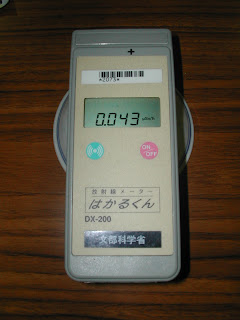Please take a look at Iida-san's blog. http://minami-kajuen.dreamlog.jp/archives/51312200.html
This is called a Diamond Fuji. He wrote that he took the photos yesterday. The sunset began at 16:37 and took only two minutes. Isn't that a gorgeous sunset? He has been trying to capture a Diamond Fuji, but he wrote he was only successful once in February. So, this is the second time this year. He lives in Meguro, Tokyo, not close to Mt. Fuji. He is my Kana Shodo teacher's husband.
Monday, October 31, 2011
Tuesday, October 25, 2011
Measuring Radioactivity
On Oct. 22nd and 23rd, Tokyo Institute of Technology had the yearly festival, and I attended a few lectures on the Fukushima Daiichi disaster and radioactivity and also a program to measure radioactivity. This is my first time to visit this campus.
I got off at Oookayama station and walked into the campus to the green district.
This was on 23rd. We did some experiments.
These are samples we were going to measure their radioactivity.
Hakarukun is the name of this device. It means Mr. Measuring. I placed it on a Chinese ceramic bowl. The colors and glaze emit radioactive material. After a minute or so, it did go up, but very little.
A student is measuring a tiny piece of uranium.
A man in our group suspected this corner. So, I placed my hakarukun there.
0.204 micro sievelt. It was the highest I measured that day.
I wanted the device, but I heard it costs over 1000 or 2000 dollars.
This was toward the end of the day, but the campus was full of people and foods and entertaiment everywhere.
He had a cafe across our lecture hall. I wasn't sure what they served because it was dark inside.
Kaneko Takeshi san (金古 岳史さん)and me. He took my application and helped me to do my experiment. They are all very helpful. Also the lectures were excellent.
I saw alpha rays like tiny lightening. It was neat.
Thursday, October 13, 2011
Kana Shodo and Your Name
Rebbecca Hill
Above is a page of my kana dictionary that shows a variety of るwhich is close to the pronunciation of lu, ll, or ru. In Japanese, lu, ll, and ru sound the same. In this post, I want to show you different る from the documents from the Heian period. In kana shodo, we can pick and choose a style according to our needs. In Rebbecca's, I tried to imitate a small るfrom the dictionary. It is my most favorite る. It isn't that I succeeded. I can write better later on, I hope. But I wanted to show you this part of fun in kana shodo.
Below is Luciana Lhullier. On this one, I simply wrote a standard hiragana る. But as you can see comparing with above photo, it comes from the Heian period. Right? So, if you learn modern Japanese hiragana, you can read 1000 years old kana documents with help. Yes, you can read at least bits and pieces of an ancient text like Genji Monogatari! I hope to show you that later on since many of my readers are very interested in kana shodo. The other day, my blog rating shot up to 500 at Red Room! That was unprecedented. People are especially curious about kana shodo plus all the Japanese pop culture.
I realized that I probably need to write Lu's once more. I wrote るうり, but I think るうりあis better.
Lu, if you can, please let me know how to pronounce your last name. I'll make it as close to your name as possible.
Vincent
Vincent, if you let me know your full name, I'll rewrite it. Please let me know.
Aberjhani
Ashok Malhotra
Jitu Rajgor
Jitu, I'm unsure how to pronounce your last name. Please let me know so that I can improve this later on.
Monday, October 10, 2011
My Aunt's Lacquered Bamboo Basket
This basket belonged to my aunt who passed away. She had this basket in her Tokyo home. I was four or so then. She brought this basket with other items to the U.S. with her. She lost most of them except the basket. Still, the basket looks new after more than 55 years. It has fine shine from quality lacquer. Japan does not produce much domestic lacquer anymore. I've seen many fine and interesting baskets in museums, but this basket comes to top in my opinion.
Subscribe to:
Posts (Atom)






























